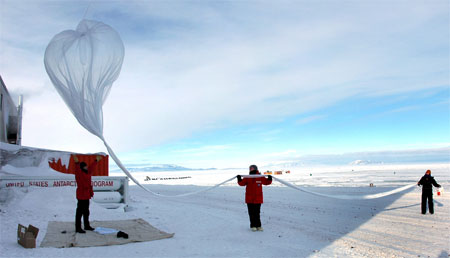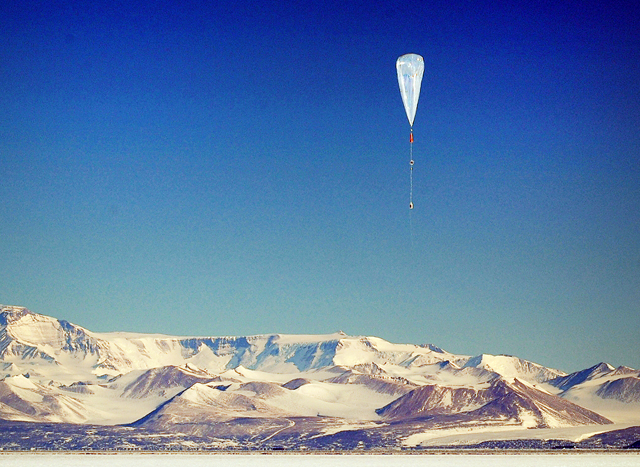Flying highBalloon-borne project teams U.S. and French scientists in atmospheric researchPosted July 16, 2010
When an international team of scientists lands at McMurdo Station And that’s a good thing if you’re interested in learning about what’s happening in the atmosphere above the continent at one of the harshest times of the year. The mostly French and American researchers will launch as many as 18 long-duration balloons to float in the atmosphere at about 20 kilometers altitude. The “launch pad” will be from a field camp on the sea ice in front of the U.S. Antarctic Program’s These super-pressure balloons, capable of maintaining a level altitude, will carry a host of different instruments for measuring everything from basic atmospheric properties like temperature and humidity, including their profiles to the ice surface, to the processes involved in ozone depletion over Antarctica. The project, a holdover from the International Polar Year “Concordiasi is motivated by the urgent need to reduce uncertainties in diverse, but complementary, fields in Antarctic science,” said Florence Rabier, with Centre National de Recherches Météorologiques “The project involves many instruments and institutes, which is always an organizational challenge,” she said via e-mail. “However, it is also a strength, as many scientists from different backgrounds have an interest in the field campaign, which can only lead to interesting scientific results.” Clouding the issueOne of the scientists is Terry Deshler 
Photo Credit: Peter Rejcek/Antarctic Photo Library
University of Wyoming scientists release a sounding balloon at McMurdo Station in 2006.
Scientists have learned much about the chemistry and physics behind ozone depletion over the years — but not everything. One of the missing pieces involves the formation of particles in polar stratospheric clouds (PSCs). The PSCs in the stratosphere provide the “platform” on which the chemical reactions occur that destroy ozone. [See Ozone Refresher for more detail.] In particular, Deshler’s team wants to learn more about the formation of nitric acid tri-hydrate (NAT), one of three types of particles that form in PSCs. The three types of PSC particles nucleate at slightly different temperatures around the minus 80 degrees centigrade barrier. Knowing the conditions under which the NAT particles form could help with ozone depletion forecasting around the world. “If you want to model polar ozone loss, you need to decide which temperature you’re going to allow polar stratospheric clouds to form,” Deshler said. 
Photo Credit: Ken Klassy/Antarctic Photo Library
Nacreous clouds, also known as polar stratospheric clouds, above McMurdo Station.
That sort of information just isn’t possible to get using the sounding balloons the University of Wyoming team has launched each year from McMurdo Station for PSC measurements. Those balloons provide vertical profiles of particle size and number in a PSC as they soar to 35 kilometers and then parachute back to Earth. “This information has helped [us] develop techniques to identify NAT within PSCs, but not to determine its formation temperatures, since these flights last only about three hours and do not follow air parcels,” Deshler said. The instruments that will be aboard the balloons launched by the French space agency Centre National d’Etudes Spatiales (CNES) “That’s the capability we’ve never had before: Fly at a reasonably constant altitude and constant density surface and remain aloft for weeks if not months,” said Deshler, a professor in the University of Wyoming’s Department of Atmospheric Sciences |



For USAP Participants |
For The Public |
For Researchers and EducatorsContact UsU.S. National Science FoundationOffice of Polar Programs Geosciences Directorate 2415 Eisenhower Avenue, Suite W7100 Alexandria, VA 22314 Sign up for the NSF Office of Polar Programs newsletter and events. Feedback Form |


